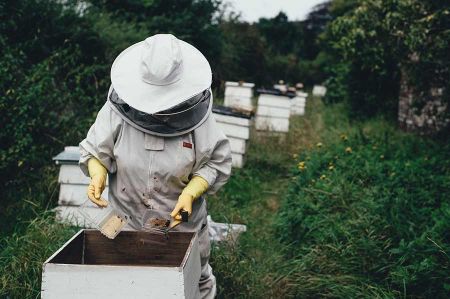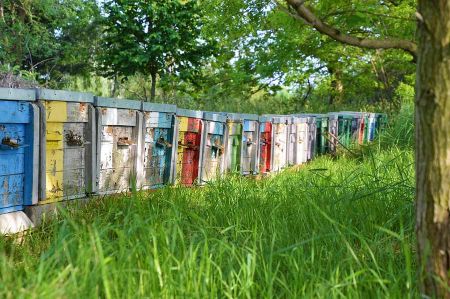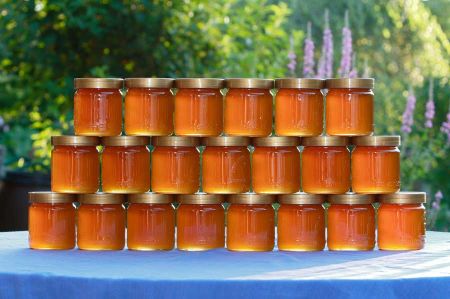People were already familiar with honey as a food in the Stone Age, as 9,000-year-old Stone Age cave and wall paintings with human “honey hunters” show.
Honey was initially the only known sweetener among settled ethnic groups. The honey “stolen” from wild bee colonies was also used as bait in bear hunts. The origin of domestic beekeeping with humanely planned honey extraction dates back to the 7th millennium BC. Suspected in Anatolia.
The healing properties of honey are described in the Koran
 Honey was also found as a grave offering during excavations of pharaohs' tombs in Egypt. Around 3000 BC In ancient Egypt, honey was considered the “food of the gods” and a source of immortality: a pot of honey had a value comparable to that of a donkey. Around 400 BC In the 4th century BC, Hippocrates taught that honey ointments reduced fever and that honey water helped improve the performance of athletes in the ancient Olympic Games.
Honey was also found as a grave offering during excavations of pharaohs' tombs in Egypt. Around 3000 BC In ancient Egypt, honey was considered the “food of the gods” and a source of immortality: a pot of honey had a value comparable to that of a donkey. Around 400 BC In the 4th century BC, Hippocrates taught that honey ointments reduced fever and that honey water helped improve the performance of athletes in the ancient Olympic Games.
According to Augustine, honey is a picture of God's tenderness and goodness. The healing properties of honey are described in the Koran. In the 16th Sura (an-Nahl, in German: The Bee), verses 68-69, it is reported that “the bee was commanded by inspiration to eat of all fruits and thereby produce honey and that the honey for has a healing effect on people.” In a cookbook from 1547, the author also speaks of the effects assumed at the time: “Rose honey strengthens and cleanses the stomach/from bad dampness/cleanses and heals severe/feeble and damage to the mouth/gums/throat and gurgling”.
 Today, along with other bee products, honey is also used as a remedy in natural medicine as part of apitherapy. According to current German law, the healing effects of foods cannot be advertised and honey itself cannot be described as a remedy. When applied to an injury, honey has a mild anti-inflammatory effect, reducing swelling, increased temperature and local pain. It promotes the growth of so-called fibroblasts, which means that the wound heals more evenly and there is less scarring. Honey is used as a wound dressing because it has a slightly antiseptic effect and also breaks down dead tissue in wounds. The antiseptic effect is produced, among other things, by hydrogen peroxide, but due to its small proportion, the substance only plays a minor role in the overall mixture. Special types of honey are therefore increasingly being used in wound treatment.
Today, along with other bee products, honey is also used as a remedy in natural medicine as part of apitherapy. According to current German law, the healing effects of foods cannot be advertised and honey itself cannot be described as a remedy. When applied to an injury, honey has a mild anti-inflammatory effect, reducing swelling, increased temperature and local pain. It promotes the growth of so-called fibroblasts, which means that the wound heals more evenly and there is less scarring. Honey is used as a wound dressing because it has a slightly antiseptic effect and also breaks down dead tissue in wounds. The antiseptic effect is produced, among other things, by hydrogen peroxide, but due to its small proportion, the substance only plays a minor role in the overall mixture. Special types of honey are therefore increasingly being used in wound treatment.
The ancient Egyptians already knew about the healing power of honey
Natural honey or honey “from a jar” is not suitable for treating wounds. Although germs cannot multiply in honey, it cannot be completely ruled out that they are present as contaminants in honey. The honey used for medical purposes is therefore sterilized with the help of gamma rays before use. In contrast to thermal sterilization, the enzymes that play a key role in the healing effect are not destroyed.
The ancient Egyptians already knew about the healing power of honey. Now there is a scientific study from Iran: The study shows that a combination of coffee and honey can be more effective than cortisone in the treatment of dry coughs. Typical course of an illness: The cold is gone, the cough remains. Following an upper respiratory tract infection, there may be a persistent scratchy feeling in the throat and paroxysmal coughing attacks, a so-called post-infectious dry cough.
In a randomized, double-blind study at the University Hospital in Tehran, patients with a post-infectious dry cough received either 500 grams of honey mixed with 70 grams of instant coffee or 600 grams of thickened sugar juice with 320 milligrams of cortisone (prednisolone) or 600 grams of sugar juice with a cough-relieving drug (with guafenesin). Patients were instructed to dissolve one tablespoon of the paste in a glass of hot water and drink it three times a day.
Result: The honey-coffee mixture proved to be highly effective, more effective than the sugar-cortisone mixture. The cough-relieving medicine had hardly any effect in this study.
Please read as well:
Lets go to German Fastnacht Museum in Kitzingen
Strandsegeln auf den Flächen des IJmuden-Strandes


